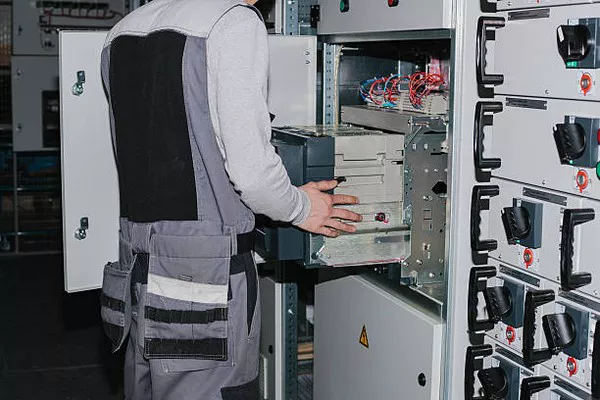Power transformers are an essential component of our modern electrical distribution systems. They play a crucial role in transmitting electricity efficiently from power generation plants to our homes and businesses. These silent giants facilitate the transformation of voltage levels, ensuring that electricity can travel across long distances with minimal loss. In this article, we will delve into what power transformers are, how they work, their types, and their significance in our daily lives.
Understanding Power Transformers
A power transformer is an electrical device designed to transfer electrical energy between two or more circuits through electromagnetic induction. It operates on the fundamental principles of Faraday’s law of electromagnetic induction and the relationship between voltage and current. Power transformers are essential in managing voltage levels and ensuring that electrical power is distributed safely and efficiently across different stages of the grid.
How Do Power Transformers Work?
At its core, a power transformer consists of two coils, known as the primary and secondary windings, which are wound around a common iron core. The primary winding is connected to the input voltage, typically at a high voltage level, while the secondary winding is connected to the output, usually at a lower voltage level. The iron core serves to provide a magnetic path for the flow of magnetic flux generated by the primary winding.
When alternating current (AC) voltage is applied to the primary winding, it generates a magnetic field that continuously changes in strength and direction due to the alternating nature of the current. This changing magnetic field induces a voltage in the secondary winding through electromagnetic induction. The voltage induced in the secondary winding is proportional to the ratio of the number of turns in the secondary winding to the number of turns in the primary winding.
The transformation ratio, which determines the voltage transformation between the primary and secondary windings, is the key factor in power transformers. By varying the number of turns in the primary and secondary windings, transformers can step up or step down voltage levels as required for efficient transmission and distribution of electrical power.
Types of Power Transformers
Power transformers come in various types, each designed for specific applications and voltage requirements. The most common types include:
Distribution Transformers: These transformers are used to step down high-voltage electricity from transmission lines to lower voltage levels suitable for distribution to homes and businesses. They are often found on utility poles and in substations.
Power Transformers: These transformers are used in power generation plants to step up the voltage of electricity generated by generators before it is transmitted over long distances through high-voltage transmission lines.
Instrument Transformers: These transformers are designed for measurement and protection purposes in the power system. They include current transformers (CTs) and voltage transformers (VTs) used in metering, relaying, and protection systems.
Auto-transformers: These transformers have a single winding with multiple taps, allowing them to provide multiple voltage ratios. They are commonly used in voltage regulation applications.
Phase-Shifting Transformers: These specialized transformers are used to control the phase angle of electrical currents, enabling efficient power flow control in complex grid systems.
The Significance of Power Transformers
Power transformers are the backbone of electrical distribution for several reasons:
Voltage Transformation: They allow for efficient voltage transformation, which is crucial for long-distance power transmission and safe distribution to end-users.
Energy Efficiency: Power transformers minimize energy loss by reducing the current needed for transmission. Higher voltage levels result in lower current levels, which in turn reduce resistive losses along the transmission lines.
Grid Stability: They contribute to the stability of the electrical grid by balancing voltage levels and providing a buffer against voltage fluctuations.
Isolation and Safety: Transformers provide electrical isolation between the primary and secondary circuits, enhancing safety and reducing the risk of electrical shock.
Versatility: The availability of various types of transformers makes it possible to adapt to different voltage requirements and grid configurations.
FAQs
What is the lifespan of a power transformer?
Power transformers are built to be durable and can have a lifespan of 30 to 50 years or more with proper maintenance. Regular inspections, oil testing, and maintenance routines can extend their operational life.
What are the common maintenance practices for power transformers?
Maintenance practices for power transformers include monitoring oil quality, checking insulation, tightening connections, and conducting periodic tests, such as dissolved gas analysis, to assess the transformer’s health.
Can power transformers be overloaded temporarily?
Power transformers are designed to handle short-term overloads within specified limits. However, sustained overloading can lead to overheating and reduced transformer life. It’s essential to adhere to recommended loading guidelines.
Do power transformers emit harmful radiation or noise?
No, power transformers do not emit harmful radiation or noise during normal operation. They operate quietly and pose no health risks to nearby residents.
Are there environmental concerns associated with power transformers?
While power transformers contain oil for cooling and insulation purposes, newer transformers use environmentally friendly insulating oils with reduced environmental impact. Transformer oil recycling and disposal processes are also in place to mitigate environmental concerns.
Conclusion
Power transformers are the unsung heroes of our electrical infrastructure, enabling the efficient transmission and distribution of electrical energy. Their ability to step up or step down voltage levels is instrumental in maintaining grid stability, reducing energy loss, and ensuring safe and reliable power supply to our homes and businesses. Understanding the principles and types of power transformers is essential for appreciating their vital role in our daily lives. As technology advances, power transformers continue to evolve, becoming more efficient, environmentally friendly, and integral to the sustainable future of energy distribution.

